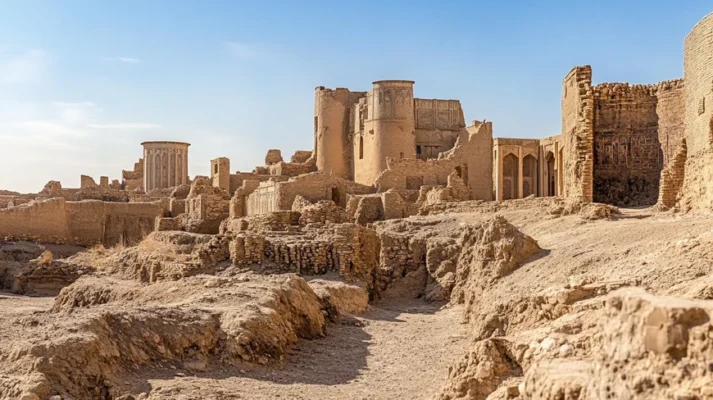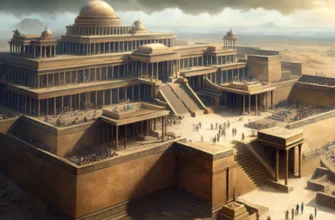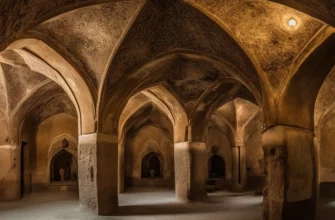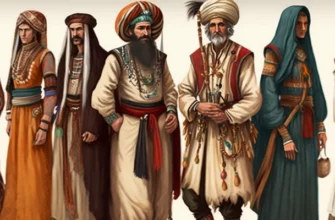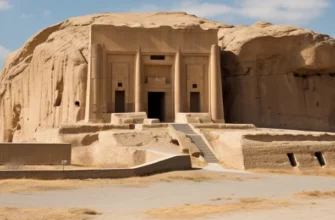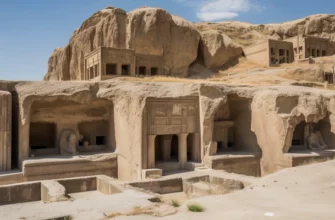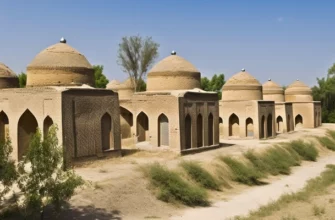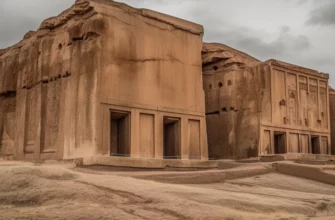Istakhra is an ancient city located in southern Iran, not far from the ruins of the famous Persepolis. It emerged after the fall of the Achaemenid Empire and became an important political and religious center during the Sassanid Empire (3rd–7th centuries AD).
Istakhr gained great importance as a center of Zoroastrianism, as well as a center for the revival of Persian culture after Greek and Parthian influence. The city impressed with its architecture: palaces, fire temples, administrative buildings. It served as the residence of the Sassanid kings until the founding of the new capital, Ctesiphon.
The decline of Istakhr began after the Arab conquest in the 7th century. The city gradually lost its importance and fell into ruin. Archaeological excavations, which have been ongoing since the 19th century, have uncovered many valuable artifacts that shed light on its glorious past.
Today, Istakhr is an important historical monument that preserves the spirit of the glorious Persian civilization in its ruins.
- Location and geography
- Foundation of the city
- The heyday of the city
- Political and religious significance
- Center of Zoroastrianism
- Role in the Sassanid Empire
- Architecture and culture
- Temples and palaces
- Art and writing
- Decline and ruin
- Arab conquest
- Loss of strategic importance
- Archaeological research
- The significance of Istakhr in the history of Iran
- Conclusion
Location and geography
Istakhr was located in southern Iran, in the province of Fars, not far from the ruins of Persepolis, the capital of the Achaemenid Empire.
The city occupied a strategic position between the Zagros mountain ranges and fertile plains, which contributed to its development as a commercial and religious center.
Its proximity to ancient trade routes provided access to resources and facilitated cultural exchanges.
Thanks to its moderate climate and the availability of water from the Pulavar River, Istakhr had favorable conditions for agriculture and life. Istakhr arose in close proximity to Persepolis, the former capital of the Achaemenid Empire, destroyed by the armies of Alexander the Great.
This location was not accidental: the new city was intended to preserve the symbolism and continuity of the ancient Persian state.
Its proximity to Persepolis allowed Istakhr to absorb the architectural traditions and religious practices of its ancestors, as well as to strengthen the legitimacy of the Sassanid rulers, who sought to restore the greatness of Persia. The ruins of Persepolis remained an important place of worship and cultural memory, and Istakhr gradually became the center of a new Persian revival.
The area around Istakhr has a semi-arid climate with hot, dry summers and mild, short winters. This climate was typical of southern Iran, but thanks to its proximity to the Zagros Mountains and the Pulavar River, Istakhr had better water resources than many other regions.
Fertile valleys and irrigation systems ensured the development of agriculture, including the cultivation of wheat, barley, grapes, and fruits. The natural conditions were favorable not only for agriculture but also for the settlement and growth of the city, which became an important center for several centuries.
Foundation of the city
Istakhr was founded in the first centuries after the fall of the Achaemenid Empire, probably in the 4th–3rd centuries BC, although the city experienced its heyday during the Sassanid era. Its emergence was a response to the need to revive Persian traditions after Greek and Parthian rule.
The new city emerged near the ruins of Persepolis, not only as a practical center but also as a symbol of national identity. Istakhr quickly gained importance as a religious center, especially for Zoroastrians, who considered it a sacred place.
Istakhr later became one of the first important cities of the Sassanid Empire, and some sources even mention that the founder of the dynasty, Ardashir I, came from there.
The exact date of Istakhr’s founding remains a subject of debate, but most historians believe that the city emerged between the 4th and 3rd centuries BC, after the destruction of Persepolis by Alexander the Great’s army in 330 BC. At that time, Persia was experiencing political and cultural decline, which stimulated the need for a new center that would preserve the traditions of the Achaemenid state.
The final rise of Istakhr took place in the 3rd century AD, when Ardashir I founded the Sassanid Empire. It was then that the city became an important administrative and religious capital of the new kingdom, and its history became closely intertwined with the history of the revival of Persian power.
After the fall of Persepolis and the decline of the Achaemenid Empire, the Fars region was left without a powerful political and religious center. The construction of Istakhr was an attempt to preserve and restore Persian identity in new historical conditions. The ancient Persians wanted a place that would not only symbolize past greatness but also become a platform for cultural, spiritual, and political revival.
In addition, the city was conveniently located near fertile lands and important trade routes, as well as close to the sacred ruins of Persepolis. This allowed Istakhr to function as both a religious center of Zoroastrianism and an administrative hub for the future Sassanid state.
It was from Istakhra that Ardashir I began his struggle against the Parthian Empire, which ended with the founding of a new empire — the Sassanid Empire.
The heyday of the city
Istakhra’s greatest heyday was during the Sassanid Empire (3rd–7th centuries AD). Since the accession of Ardashir I, Istakhr became an important political, religious, and cultural center. The city became the stronghold of a new dynasty that sought to revive the greatness of the Achaemenids, relying on ancient Persian traditions.
The city was of particular importance to the Zoroastrian religion — it was home to the main fire temples, sacred texts were kept here, and the top clergy lived here. Istakhra effectively became the spiritual capital of the empire alongside the official political capital, Ctesiphon.
Architecturally, the city was distinguished by its palaces, shrines, and monumental structures. During this period, crafts, trade, writing, and art flourished, and its strategic and economic importance in the region grew.
The heyday of Istakhr attests to its unique role as a symbol of the revival of Iranian culture after centuries of foreign influence.
Political and religious significance
Istakhr gained enormous political significance after Ardashir I chose it as one of the main residences of the Sassanid dynasty. Thanks to its strategic location, proximity to Persepolis, and important trade routes, the city became an important administrative center for the new empire. The Sassanids used Istakhr to reinforce their claim to the Achaemenid legacy, restoring the Persian monarchical tradition. Istakhr also had great religious significance.
It became an important center of Zoroastrianism, a major shrine for followers of this religion. There were numerous fire temples here, where rituals were performed that reinforced Istakhr’s spiritual role as a sacred city. Zoroastrian shrines and cultural traditions played an important role in the national identity of the Sassanid state.
The city became a symbol of Persian religious and cultural heritage, and its political and religious significance helped to consolidate the power of the Sassanids throughout the empire.
Center of Zoroastrianism
Istakhr played an important role as the religious center of Zoroastrianism, the main religion of the Persian empires. Zoroastrianism, founded by the prophet Zarathustra, was not only a spiritual practice but also an integral part of the state ideology, which strengthened the authority of the rulers of the Sassanid dynasty.
Istakhr became a place where sacred texts were kept, religious rituals and celebrations were held, and numerous fire temples, the main shrines of the Zoroastrians, operated. These temples played an important role in spiritual life: fire was considered a symbol of divine light and purity, and its maintenance was an important part of religious practice.
The city became an important center of the clergy, which not only performed religious functions but also actively influenced the political life of the empire. The Sassanid rulers supported and promoted Zoroastrianism, which contributed to the strengthening of religious homogeneity within the vast empire.
Thus, Istakhra was not only a political center but also a symbol of the religious and cultural unity of the Sassanid state.
Role in the Sassanid Empire
Istakhri played a key role in the political and religious life of the Sassanid Empire, becoming an important center of administration, culture, and spirituality. After the founding of the empire by Ardashir I, Istakhri not only became the center of state power but also a symbol of the revival of Persian greatness after the decline of the Achaemenid dynasty.
Istakhr was strategically located at the crossroads of important trade routes, which ensured its economic prosperity. At the same time, the city became an important political center where solemn ceremonies were held and important decisions for the empire were made.
Zoroastrianism, which became the state religion, further strengthened Istakhr’s spiritual authority. The city became not only the religious capital of the empire, but also the venue for important religious councils, where decisions were made that determined the development of Zoroastrian traditions in the empire.
Thus, Istakhra was not only a symbol of imperial power, but also a center of spiritual life that ensured the unity of the Sassanid Empire and provided it with stability during its heyday.
Architecture and culture
Istakhra was not only a political and religious center, but also an important center of the architectural and cultural heritage of the Sassanid Empire. The city’s architecture reflected the grandeur of the empire and its spiritual values. The most significant architectural monuments were palaces, fire temples, and other monumental structures that demonstrated the grandeur and ambition of the Sassanids.
Fire temples, which were the main shrines of Zoroastrianism, were of great importance. The architecture of these temples usually included huge domes and high walls symbolizing the divine power of fire, as well as spacious interior rooms for worship. One of the most famous temples in Istakhra was the fire temple, where important religious ceremonies were held, uniting spiritual and political power.
In addition to religious buildings, the city also had palaces, fortresses, and other architectural ensembles that emphasized the power of the empire. Sassanid architecture was famous for its use of arches, domes, and engineering solutions that became models for many subsequent eras.
The cultural life of Istakhra was multifaceted and included the development of literature, art, and crafts. Painting, engraving, music, and poetry flourished here, reflecting elements of Persian mythology and Zoroastrian philosophy. Crafts, particularly weaving, pottery, and metallurgy, also reached a high level, providing the city with not only luxury but also economic prosperity.
Istakhra was a cultural center that preserved and passed on the rich traditions of Persian civilization, which were of great importance for the development of the Sassanid Empire and the entire Middle East.
Temples and palaces
The architecture of Istakhr was represented by magnificent temples and palaces that served as both religious and political centers. These structures not only reflected the grandeur and power of the Sassanid Empire, but also formed an important part of the religious and cultural life of the city.
Fire temples were among the most important architectural monuments of Istakhra. They played a central role in Zoroastrian rituals and the worship of fire, which was considered a symbol of divine light. One of the most famous fire temples in Istakhra was probably located in the central part of the city. These temples had distinctive dome-shaped roofs and huge assembly halls where religious rituals and other important ceremonies were held. Architectural elements of the temples, such as high walls, large arches, and decorative elements, symbolized divine rule.
The Sassanid palaces in Istakhri were distinguished by their grandeur and luxury. The palaces were important residences for rulers and members of the nobility, as well as venues for solemn state ceremonies. They usually included large reception halls, private quarters for the royal family, and spacious inner courtyards. Architectural solutions such as the use of arches, columns, and elegant decorative elements emphasized the grandeur of the rulers.
A distinctive feature of Istakhri architecture was its ability to combine functionality with aesthetic expressiveness. These temples and palaces not only served practical functions but also became symbols of the imperial power and cultural wealth of the Sassanids.
Art and writing
The art of Istakhr, as in the Sassanid Empire as a whole, was closely linked to religious and political ideas. Persian artists created magnificent works that reflected the grandeur of the empire and its spiritual beliefs. The main art forms of the time included painting, engraving, sculpture, and decorative arts.
Painting and engraving in Istakhri depicted both historical scenes and religious motifs related to Zoroastrianism and mythology. The subjects often included images of kings, gods, and holy figures, as well as scenes from the lives of rulers.
This art was also a tool for propaganda of imperial power, reflecting the greatness and might of the Sassanids. Sculpture and reliefs depicted gods, kings, and important historical events. These works were of great importance for religious ceremonies and state celebrations. One of the most significant features of Sassanid sculpture is the depiction of majestic figures of rulers and warriors, expressing the idea of the empire’s unbreakable power. Decorative and applied arts included the manufacture of luxurious household items: textiles, ceramics, jewelry, and metalwork.
Persian craftsmen were renowned for their exquisite gold, silver, and gemstone work.
In terms of writing, the Pahlavi, an ancient Persian alphabet used for administrative, religious, and literary texts, was widely used in Istakhri. Pahlavi was the main written form for official documents and texts of the Zoroastrian religion. Persian literature, which included poetry, philosophical treatises, and sacred books, was also of great importance and was preserved and copied in monasteries and temples, particularly in Istakhri.
The art and writing of Istakhr played an important role in preserving and developing Persian culture, helping to pass on the Sassanid heritage to future generations.
Decline and ruin
The decline of Istakhra began after the fall of the Sassanid Empire in the 7th century CE, when Arab conquerors arrived in Iran. In 651, after the defeat of the last Sassanid shah, Yazdgerd III, Iran fell under Arab rule, and since then many Persian cities, including Istakh, have suffered significant destruction.
Although Istakhr was one of the important centers of the Sassanid Empire, it could not withstand the Arab invasion. The city fell victim to destruction, and many of its architectural monuments were partially or completely destroyed. From that time on, Istakhr lost its status as a major political and religious center.
The city was never restored and eventually became nothing more than ruins. However, even centuries after its decline, Istakh was still an important site for archaeologists and historians, as its ruins contained numerous evidence of the cultural flourishing of the Sassanids.
Today, Istakhra is an important archaeological site where scientists conduct excavations, exploring the remains of the ancient city and restoring some of its former glory. The preserved ruins provide valuable information about the culture, architecture, and life during the Sassanid period and serve as a reminder of how important Istakhra was for its era.
Arab conquest
The Arab conquest of Iran in the mid-7th century was a decisive stage in the decline of Istakhr. In 633, Arab troops belonging to the Rashidun Caliphate began their invasion of Iran.
After several series of battles and military campaigns, Arab forces, led by generals such as Khalid ibn al-Walid, defeated the Sassanid rulers and gained control over most of Iran.
The fall of the Sassanid Empire came after the defeat of the last Shah, Yazdgerd III, at the Battle of Nehavand in 642. The Sassanids were unable to restore their power, and the Arab conquest gradually spread throughout Iran, including the city of Istakh, which by that time was already an important religious and political center.
Istakh, as one of the main centers of the Sassanid Empire, was not only a political but also a religious center. Its fire temples, which served as places of worship for Zoroastrians, became targets for Arab conquerors seeking to spread Islam. As a result of the conquest, many of these temples were destroyed or converted into mosques.
The Arab conquest was not instantaneous and lasted several decades. However, by the beginning of the 8th century, Iran was completely integrated into the Arab caliphates. Istakhf, although it remained an important city, gradually lost its significance, and its role as a political and religious center was reduced.
In particular, the conversion to Islam as a result of the Arab conquest changed the religious map of the region. Istakh, which had been one of the largest centers of the Zoroastrian faith, gradually adapted to the new religious reality, which had a significant impact on its social and cultural structure.
Loss of strategic importance
After the Arab conquest and the fall of the Sassanid Empire, Istakhri, although it remained an important city, gradually lost the strategic importance it had during the Sassanid period.
Change of political center
After the Arab conquest of Iran, the capital and administrative centers of the empire were moved to other locations, notably Baghdad, which became the new capital of the Abbasid Caliphate. Although Istakhri retained a certain place in the region, it no longer had the political and economic influence it had enjoyed during the Sassanid era.
Conversion to Islam and cultural orientation
The Arab conquest brought Islam with it, and within a few generations, the Persian lands significantly changed their cultural and religious identity. Religious and cultural centers associated with Islam began to dominate the ancient Zoroastrian centers. The city of Istakh, which had previously been an important center of Zoroastrianism, lost its religious significance with the Islamization of the region.
Transportation and trade routes
After the Arab conquest, trade routes changed. Istakh lost its strategic importance as a crossroads between the East and West. New administrative centers that emerged after the Arab conquest, such as Baghdad and Kufa, quickly became major economic and trade hubs. This led to the economic decline of Istakhr.
Loss of defensive functions
After the Arab conquest, the city was no longer needed as a fortress, as new administrative systems changed defensive strategies. Istakh, although still important from a historical point of view, did not have the strategic importance as a military center that it had during the Sassanid period.
Deterioration of the economic situation
Istakhr, as a commercial and industrial center, lost its importance due to the shift in trade flows and changes in economic structures. After the Arab conquest, the city gradually lost its former grandeur, and the economy declined due to new political conditions.
Thus, Istakhr lost its strategic importance with the arrival of the Arabs, which led to significant changes in its political, religious, and economic life. The city, once an important center of the empire, became one of the many provinces that gradually fell into decline.
Archaeological research
Archaeological research on Istakhr, one of the important cities of ancient Iran, began in the mid-20th century and continues to this day. Thanks to numerous excavations, it has been possible to uncover numerous architectural monuments, household items, and artifacts that provide insight into life in Istakhra during the Sassanid and Arab conquests.
Excavations and discoveries
The largest archaeological excavations are being carried out in the ancient city, where the remains of palaces, fire temples, defensive walls, and residential buildings have been discovered. One of the most important finds is the ruins of a fire temple, which was the central religious building of the city, as well as numerous reliefs and sculptures depicting scenes from religious life and war. Particularly impressive are the large stone steles with engraved images of kings and deities.
Religious and cultural artifacts
Archaeologists have also found a large number of artifacts related to Zoroastrianism, including cult objects, sacred hearths, and religious images. Important finds include metalwork and pottery, which indicate the high level of craftsmanship that existed in Istakhra. Many coins have also been found, reflecting the economic life of the city during different periods of its existence.
Architectural monuments
Research into the architecture of Istakhra has shown that the city was very developed in terms of construction. The large number of preserved walls and palaces confirms its importance as an administrative and cultural center. The most impressive are the remains of palaces, in which a large number of decorative elements were found — stone slabs, frescoes, and ceramics.
Interpretation of the findings
Archaeological research in Istakhra is helping to reconstruct everyday life in the ancient city. The study of materials found during the excavations provides a better understanding of life in the cities of the Sassanid Empire, particularly in the context of religion, politics, and economics. One important aspect of the archaeological research is the discovery of Zoroastrian texts and cult objects, which provide insight into the religious practices of the Persians during this period.
Preservation and research
Archaeological work in Istakhri is carried out under the auspices of Iranian archaeological institutions, as well as international organizations actively involved in the preservation of historical monuments. Increasing attention is being paid to the protection and restoration of archaeological sites, as many of them have suffered from time and natural disasters such as earthquakes.
Istakhr is now an important archaeological site, and excavations in the area continue to yield new discoveries that provide a better understanding of the culture and history of this great city. The preservation of these finds is helping to restore important pages in the history of Iran and the Sassanid Empire.
The significance of Istakhr in the history of Iran
Istakhr occupies a special place in the history of Iran due to its importance as a major political, religious, and cultural center at various stages of the country’s history. The city was one of the main centers of the Sassanid Empire, serving as an administrative and political center, as well as playing an important role in Zoroastrianism.
Istakhr was an important religious center where Zoroastrian fire temples, cult objects, and sacred texts were kept. The city became an important place for religious education and worship.
In addition, Istakhri was an important cultural center where various arts, such as architecture, painting, and jewelry, flourished. The city was famous for its palaces and other architectural monuments, which still attract the attention of archaeologists today. Istakhra was also an important center of crafts, and the works of local craftsmen became true masterpieces.
After the Arab conquest, Istakhr remained an important symbol of the preservation of Persian culture, although it became part of the Islamic world. Istakhr gradually lost its political and religious significance but remained an important center for Zoroastrians, albeit to a lesser extent.
Today, archaeological research in Istakhr is of great scientific importance for understanding the history of Iran and the Sassanid Empire. Finds from this city help to restore many aspects of ancient Persian culture and religion, and archaeological excavations allow researchers to immerse themselves in the daily life and development of this ancient city.
Although Istakhr has lost its former significance, it remains an important symbol of Iran’s cultural and religious heritage, and its history continues to inspire new generations of researchers.
Conclusion
Istakhr occupies an important place in the history of Iran as one of the main centers of ancient Persian civilization.
This city, which was a significant political, religious, and cultural center, reflects the grandeur of the Sassanid Empire and its legacy. Its temples, palaces, and other architectural monuments testify to the high level of cultural and craft development of that time. With the Arab conquest, Istakhr lost its political importance, but its religious significance remained relevant to Zoroastrians for a long time.
Today, archaeological research in Istakhr continues to uncover new pages in the history of Iran, enriching our understanding of Sassanid culture and civilization. The loss of Istakhra’s political significance did not diminish its influence on history, as its legacy still lives on in architectural finds and cultural traditions. Istakhra leaves a deep mark on the heart of Iran, providing valuable lessons for the modern world.
